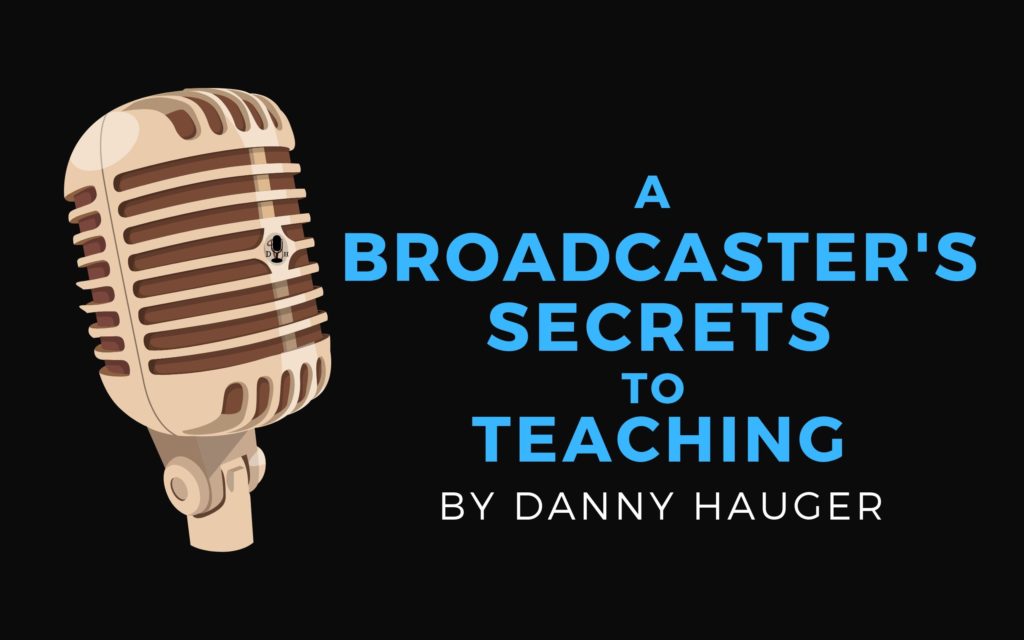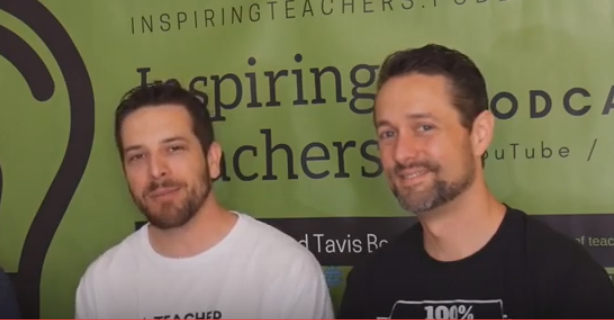By Danny Hauger
Educators, like broadcasters, should always work on developing and improving their instructional voice and message. Start by analyzing, and then refining, your vocal presentation.

Before you teach your next lesson, sit down at a microphone and record yourself teaching for two minutes. Ideally, you will be introducing the next lesson you plan to teach in the recording for a more helpful conclusion of this experiment.
You can utilize your phone, a USB-connected microphone, or a computer’s mic using a free program like Audacity to accomplish this. A professional or semiprofessional USB microphone will give you a closer idea of your actual frequency and tone quality, and is preferred ($50 to $100 will get you there).
Sit or stand as you would when you are teaching, about 1.5 to 3 feet from your recording device, to simulate the distance to your class. If you are too close, you will “peak” (add distortion) to the recording.
Hit record, and capture at least two minutes of an opening, general instructions, and some specific directions or instructions that are part of a typical lesson. Speak as if you were teaching. Project your voice just like you would during instruction. Envision your classroom and students while you speak, to be sure you are emulating the natural tone of performance. When you are finished, open a computer document or grab a piece of paper to jot down your reflections.
Questions for reflection:
1. First listen: Observe dynamics (variations in the volume). Are you louder or softer than you imagined?
a. Are you too loud, to the point where students may feel uncomfortable?
b. Are you too quiet to be heard confidently in the back of your class?
c. Do you use changes in dynamics for points of emphasis?
d. Hearing your dynamics, can you make changes that could improve your presentation? Try re-recording with these additions before proceeding with step 2.
2. Second listen: Do you sound motivated?
a. Are you alert and dedicated to your subject material, or just meandering and daydreaming while you speak?
b. Are you expressing genuine interest in the subject material?
c. Do you sound as if you are interested in learning, signaling to students that this is a lesson you look forward to teaching, to get them to sit up in their seats?
d. Did practicing make this feel less than realistic? Then put yourself in the desk of a student and play the recording again. What would you want to hear differently?

3. Third listen: Is there a clear “why” to your objective for the lesson?
a. Did you explicitly state the learning goal or target?
b. Did you explain how you were going to achieve the goal?
c. Can you apply the lesson to something else you have learned, will learn, or have used in your life? Help relate the importance of the day’s learning.
d. Did you get to the point? Does it hold the attention of your audience?
4. Fourth listen: Word usage and presentation.
a. Are your words efficient, clear, concise and meaningful? Are you using appropriate vocabulary to be understood, but perhaps also challenging students with some new words through context and example?
b. Are you using inflection and tonality to emphasize your point?
c. Do you pause for key information to process, to help students digest the information?
d. Was there a clear hook to pull students into the next segment of the lesson?
Steps for improving after reflection:
1. Too loud? Excessive force of voice can fatigue your vocal cords and vocal stability. You may be damaging your voice or making it hard for an audience to listen comfortably. Consider bringing your volume down; students will pay more attention in order to hear instructions and directions. Or walk around the room to speak, so students must track you with their eyes and ears, and you don’t need to project to the scope of the entire room. Remember that where you stand might be great for some students in the room, but detrimental to students who are too close or far away.
Too soft? Do you struggle to make out your words and syllables? Imagine what students who sit far away from you might be experiencing. Consider rearranging the room similar to an auditorium, to be heard from the center of the room.
2. Think about your motivation. Would you be interested in listening to a speaker present as you just did? If you answered no, don’t worry, this is just practice, and you can read my book for steps to build confidence and effective qualities to present in a more engaging manner. You can re-record with more enthusiasm when you feel comfortable.
Remember, your ability to encode excitement or purpose into your presentation will captivate students and improve their commitment to learning.
3. Speaking your learning objective is essential. Write it, refer to it, and state your goals explicitly if you want students to identify and achieve them.
4. Inflection is necessary to pull students in and retrieve students who daydream. Use humor, props, tangible items or kinesthetic cues to get them more involved as listeners.
5. Pausing allows students to listen, think through any prompted cognitive process, and then continue to listen. If you proceed like a train on a track, students may get caught thinking and miss the next sentence. Think of this as if you were a student learning a second language — sometimes you need to stop and consider the meaning of words, then understand them, before being ready to proceed.

6. Forward selling is a term in broadcasting that advertises what’s coming later in the show. Forward sell to hook in your audience. Then, backsell the important vocabulary and milestones of the lesson to reinforce what has been accomplished so far. This also builds a sense of accomplishment as you progress through the lesson. As a side note, any humor or jokes from early in the lesson can be used as callbacks to maintain throughlines of enjoyment for the class.
Bottom line: Repeat this test occasionally to check your progress as a dynamic speaker.
Excerpted from A Broadcaster’s Secrets to Teaching by Danny Hauger (available on Amazon). Hauger, a member of Liberty Education Association, worked in sports broadcasting before transitioning to the classroom. He also hosts the weekly podcast “Inspiring Teachers” (available on iTunes and YouTube) with Tavis Beem, a member of Mt. Diablo Education Association. More information at DannyHauger.com.
The Discussion 0 comments Post a Comment